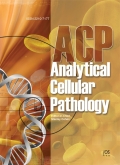Authors: Pretorius, Maria E. | Wæhre, Håkon | Abeler, Vera M. | Davidson, Ben | Vlatkovic, Ljiljana | Lothe, Ragnhild A. | Giercksky, Karl-Erik | Danielsen, Håvard E.
Article Type:
Research Article
Abstract:
Background: The clinical outcome for the individual prostate cancer patient is often difficult to predict, due to lack of reliable independent prognostic biomarkers. We tested DNA ploidy as a prognostic factor for clinical outcome in 186 patients treated with radical prostatectomy. Methods: DNA ploidy was measured using an automatic image cytometry system and correlated with preoperative PSA, age at surgery, Mostofi grade, surgical margins and Gleason score. Results: The mean follow up time after operation was 73.3 months (range 2–176 months). Of the 186 prostatectomies, 96 were identified as diploid, 61 as tetraploid and 29 as aneuploid. Twenty-three
…per cent, 36% and 62% of the diploid, tetraploid and aneuploid cases respectively, suffered from relapse during the observation time. DNA ploidy, Gleason score, Mostofi grading, surgical margins and preoperative PSA were all significant predictors of relapse in a univariate analysis. On multivariate analysis, only Gleason score and DNA ploidy proved to be independently predictors of disease recurrence. Furthermore, among the 68 cases identified with Gleason score 7, DNA ploidy was the only significant predictor of disease recurrence. Conclusions: Our data suggest that DNA ploidy should be included as an important additive prognostic factor for prostate cancer, especially for patients identified with Gleason score 7 tumours.
Show more
Keywords: DNA ploidy, Gleason, prognosis, prostate cancer, radical prostatectomy
DOI: 10.3233/CLO-2009-0463
Citation: Analytical Cellular Pathology,
vol. 31, no. 4, pp. 251-259, 2009
Price: EUR 27.50





